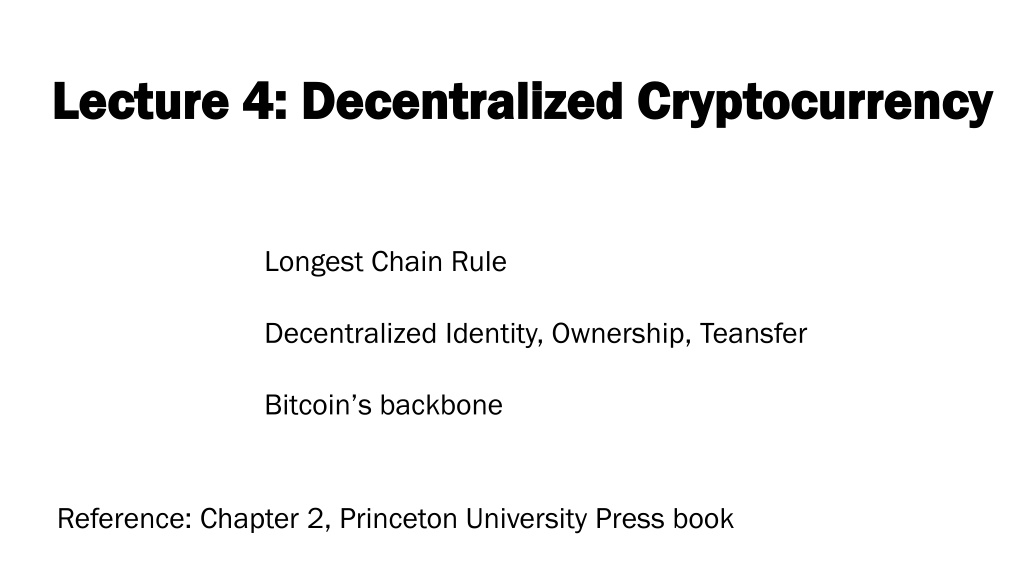Decentralized Cryptocurrency and Blockchain Technology
Exploring the concepts of decentralized cryptocurrency, the longest chain rule, ownership transfer, and ScroogeCoin within the context of blockchain technology. Detailed explanations on creating coins, transactions, blocks, and the formation of a tamper-resistant blockchain. The centralization aspect involving Scrooge and its drawbacks are also discussed.
Download Presentation

Please find below an Image/Link to download the presentation.
The content on the website is provided AS IS for your information and personal use only. It may not be sold, licensed, or shared on other websites without obtaining consent from the author. Download presentation by click this link. If you encounter any issues during the download, it is possible that the publisher has removed the file from their server.
E N D
Presentation Transcript
Lecture 4: Decentralized Cryptocurrency Lecture 4: Decentralized Cryptocurrency Longest Chain Rule Decentralized Identity, Ownership, Teansfer Bitcoin s backbone Reference: Chapter 2, Princeton University Press book
Basic Cryptocurrency: Basic Cryptocurrency: ScroogeCoin ScroogeCoin Coin Coin: (coinID, signature of Scrooge) Scrooge creates coins Transaction: Transaction: This: This: hash pointer to coin Alice: Alice: publickey of Alice Signed by owner of coin Transaction Transaction: Transfer of coin ownership Pay this this to Alice Alice
Two types of transactions Two types of transactions Createcoins Createcoins Paycoins Paycoins can only be created by Scrooge multiple coins created at the same time each coin has a recipient (identified via public key) consumed coins (list) coins created (list) Total wealth consumed = total wealth created Signed by owner of coins
Transactions are put into a block Transactions are put into a block Data in the Block Data in the Block consumed coins (list) coins created (list) Total wealth consumed = total wealth created Hash pointer to previous block Hash pointer to previous block Overall block signed by Scrooge Overall block signed by Scrooge
Transactions are organized into a Blockchain Transactions are organized into a Blockchain Append only Ledger Append only Ledger 1. Tamper evident information log Blockchain Blockchain of transactions Signed by Scrooge Scrooge 2. Append-only data structure 3. Head of the chain being known is enough to find tamper evidence in any internal block otherwise you d have to key track of all blocks signed by Scrooge
Centralization Centralization Scrooge Scrooge Main Property Main Property new coins can only be created by Scrooge every block has to be formed and signed by Scrooge security of ownership, transfer of coins. tamper resistant to anyone other than Scrooge tamper evident if Scrooge changes ownership Drawback Drawback Scrooge Rent seeking behavior
Decentralization Decentralization Solution: Solution: Get rid of Scrooge Questions Questions Who maintains the ledger of transactions? Who verifies validity of transactions Who creates new coins? Ideal answer: everyone everyone!
Distributed Consensus Distributed Consensus Question: Question: Who maintains the ledger of transactions? Distributed Consensus Distributed Consensus Interactive Protocol Allows distributed non-trusting nodes to come to agreement Traditional area of computer science (Byzantine Fault Tolerance) Bitcoin s consensus protocol is vastly different Bitcoin s consensus protocol is vastly different decentralized identity (permissionless setting) less pessimistic network assumptions
Decentralized Identity Decentralized Identity Public keys Public keys are used as identity identity Single entity can create vast number of identities Single entity can create vast number of identities Sybil Cannot do majority or super-majority voting
Network Assumption Network Assumption Any node can broadcast fully connected network broadcast to all all nodes into the network Every Every broadcast message reaches every albeit with some delay Bitcoin: ten minutes reaches every node
Scrooge is replaced by an Oracle Scrooge is replaced by an Oracle Time is organized into slots slots Oracle selects one of the nodes Oracle selects one of the nodes (public identities) random everyone can verify the unique winner The proposer replaces Scrooge in that slot The proposer replaces Scrooge in that slot constitutes a block with transactions validates transactions includes hash pointer to previous block signs the block
Elements of Bitcoin Elements of Bitcoin Ownership and Transfer of Coins Ownership and Transfer of Coins Integrity maintained (no stealing of coins) Tamper resistant to anyone other than the winner of that slot Tamper evident if the winner changed the block later on Resistant to Denial of Service Resistant to Denial of Service No transactions can be permanently eclipsed Liveness
Double Spend Attack Double Spend Attack Adversary can point its block to an older part of the chain Adversary can point its block to an older part of the chain Duplicate transaction inserted Plausible Deniability Plausible Deniability network latency an offline user will not know which block came earlier blocks have no wall clock reference (time stamps).
Longest Chain Rule Longest Chain Rule Nakamoto protocol Nakamoto protocol followed by participants when its their turn to propose a block attach block to tip of the longest chain in its block tree attach block to tip of the longest chain in its block tree Confirmation rule Confirmation rule wait until the transaction is buried k-deep in the longest chain
Satoshis Table Bitcoin protocol 1 deep => .45 25 deep => 0.0006 Proposing Voting G low mining rate low mining rate low throughput low voting rate ?-deep high latency

